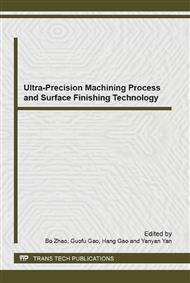p.123
p.127
p.131
p.136
p.140
p.146
p.150
p.159
p.163
Investigation of Surface Integrity on TC4-DT in High Speed Grinding with CBN Wheel
Abstract:
A series of grinding experiments were carried out with CBN wheel to focus on the surface integrity of titanium alloy TC4-DT in high speed grinding . In order to get the proper process parameters to control the surface integrity of the TC4-DT, surface roughness, subsurface morphology and microhardness variations have been studied. In addition to the use of CBN wheel, scanning electron microscopy (SEM), 3-d contour instrument and microhardness tester was applied. The results show that the surface roughness is decreased obviously when grinding wheel linear velocity rises from 60m/s to 80m/s. While the grinding speed rises from 80m/s to 100m/s, the surface roughness value increases slightly. Moreover, the surface roughness value increases with the grinding depth and the increasing trend is obvious in the process of machining. The microstructure analysis shows that during high speed grinding with CBN wheels, good quality surface with 10μm grinding depth can be obtained. Table feed rate has weak influence on the grinding surface topography. The microhardness analysis indicates that surface microhardness increases sharply with the increasing of grinding wheel linear velocity in high speed grinding.
Info:
Periodical:
Pages:
140-145
Citation:
Online since:
October 2014
Authors:
Keywords:
Price:
Сopyright:
© 2014 Trans Tech Publications Ltd. All Rights Reserved
Share:
Citation:


